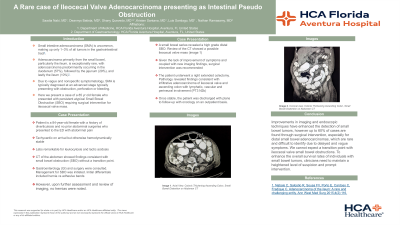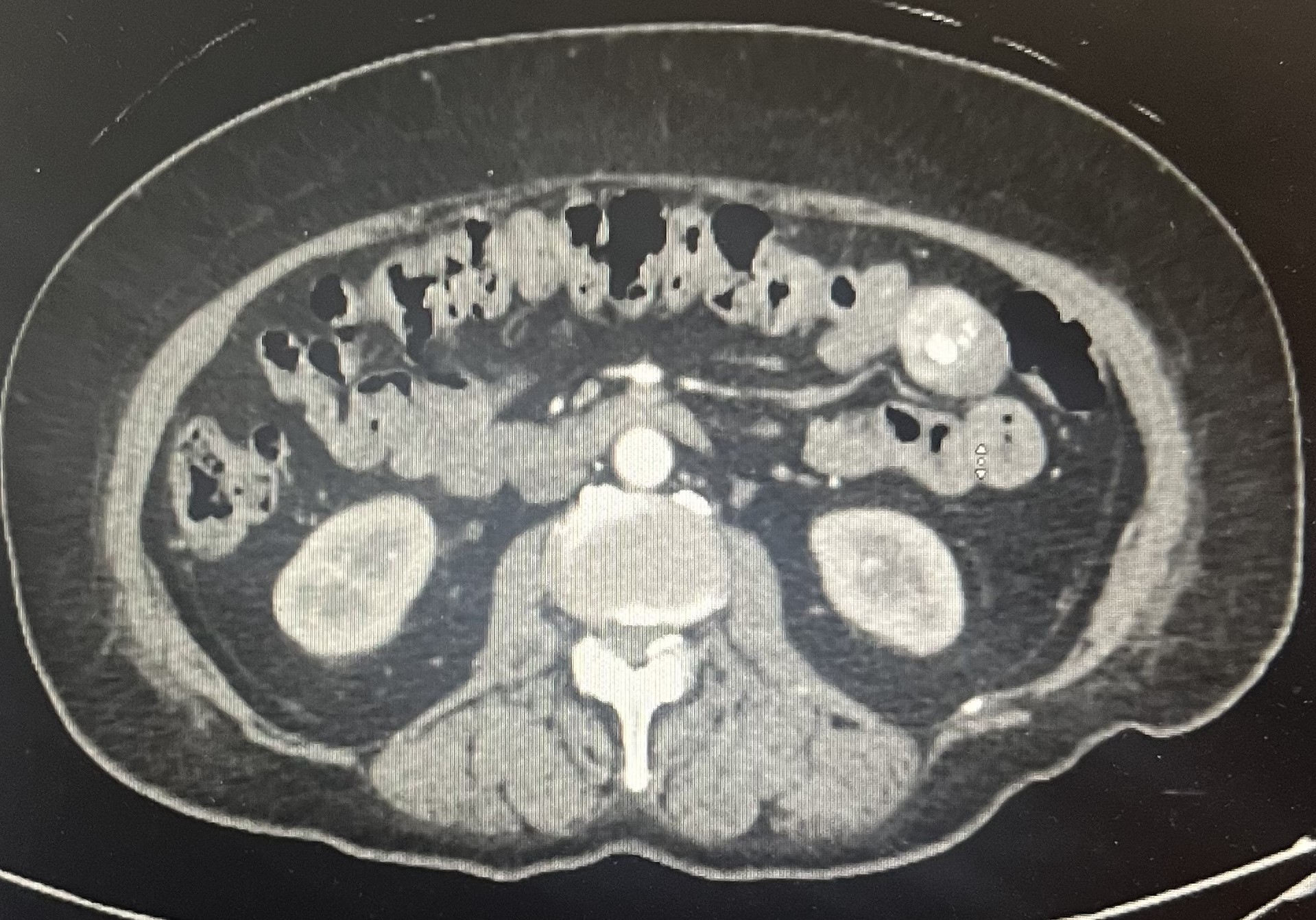Sunday Poster Session
Category: Small Intestine
P1579 - A Rare Case of Ileocecal Valve Adenocarcinoma Presenting as Intestinal Pseudo Obstruction
Sunday, October 27, 2024
3:30 PM - 7:00 PM ET
Location: Exhibit Hall E

Has Audio

Saadia Nabi, MD
Aventura Hospital
Aventura, FL
Presenting Author(s)
Saadia Nabi, MD1, Deannys Batista, MD2, Shany M. Quevedo, MD2, Kristen Santana, MD1, Luis G. Santiago Zayas, MD1, Ambar Sekulits, MD3, Ramasamy Nathan, MD1
1Aventura Hospital, Aventura, FL; 2Aventura Hospital, Miami, FL; 3Aventura Hospital, Dania Beach, FL
Introduction: Small intestine adenocarcinoma (SMA) is uncommon, making up only 1–3% of all tumors in the gastrointestinal tract1. Adenocarcinoma primarily from the small bowel, particularly the ileum, is exceptionally rare, with adenocarcinoma predominantly occurring in the duodenum (57%), followed by the jejunum (29%), and lastly the ileum (10%)1. Due to vague and nonspecific symptomatology, SMA is typically diagnosed at an advanced stage typically presenting with obstruction, perforation or bleeding. Here we present a case of a 85 yr old female who presented with persistent atypical Small Bowel Obstruction (SBO) requiring surgical intervention for ileocecal valve mass.
Case Description/Methods: Patient is a 84-year-old female with a history of diverticulosis and no prior abdominal surgeries who presented to the ED with abdominal pain. Patient was tachycardic on arrival but otherwise hemodynamically stable. Labs remarkable for leukocytosis and lactic acidosis. CT of the abdomen showed findings consistent with small bowel obstruction (SBO) without a transition point. Gastroenterology (GI) and surgery were consulted. Management for SBO was initiated. Initial differentials included hernia vs adhesive bands. However, upon further assessment and review of imaging, no hernias were noted. A small bowel series revealed a high grade distal SBO. Review of the CT showed a possible ileocecal valve mass. Given the lack of improvement of symptoms and coupled with new imaging findings, surgical intervention was recommended. The patient underwent a right extended colectomy. Pathology revealed findings consistent with infiltrative adenocarcinoma of ileocecal valve and ascending colon with lymphatic, vascular and perineural involvement (PT3 N2b). Once stable, the patient was discharged with plans to follow-up with oncology on an outpatient basis.
Discussion: Improvements in imaging and endoscopic techniques have enhanced the detection of small bowel tumors, however up to 60% of cases are found through surgical intervention, especially for distal small bowel adenocarcinomas, which are rare and difficult to identify due to delayed and vague symptoms. We cannot expect a transition point with ileocecal valve small bowel obstructions. To enhance the overall survival rates of individuals with small bowel tumors, clinicians need to maintain a heightened level of suspicion and prompt intervention.

Disclosures:
Saadia Nabi, MD1, Deannys Batista, MD2, Shany M. Quevedo, MD2, Kristen Santana, MD1, Luis G. Santiago Zayas, MD1, Ambar Sekulits, MD3, Ramasamy Nathan, MD1. P1579 - A Rare Case of Ileocecal Valve Adenocarcinoma Presenting as Intestinal Pseudo Obstruction, ACG 2024 Annual Scientific Meeting Abstracts. Philadelphia, PA: American College of Gastroenterology.
1Aventura Hospital, Aventura, FL; 2Aventura Hospital, Miami, FL; 3Aventura Hospital, Dania Beach, FL
Introduction: Small intestine adenocarcinoma (SMA) is uncommon, making up only 1–3% of all tumors in the gastrointestinal tract1. Adenocarcinoma primarily from the small bowel, particularly the ileum, is exceptionally rare, with adenocarcinoma predominantly occurring in the duodenum (57%), followed by the jejunum (29%), and lastly the ileum (10%)1. Due to vague and nonspecific symptomatology, SMA is typically diagnosed at an advanced stage typically presenting with obstruction, perforation or bleeding. Here we present a case of a 85 yr old female who presented with persistent atypical Small Bowel Obstruction (SBO) requiring surgical intervention for ileocecal valve mass.
Case Description/Methods: Patient is a 84-year-old female with a history of diverticulosis and no prior abdominal surgeries who presented to the ED with abdominal pain. Patient was tachycardic on arrival but otherwise hemodynamically stable. Labs remarkable for leukocytosis and lactic acidosis. CT of the abdomen showed findings consistent with small bowel obstruction (SBO) without a transition point. Gastroenterology (GI) and surgery were consulted. Management for SBO was initiated. Initial differentials included hernia vs adhesive bands. However, upon further assessment and review of imaging, no hernias were noted. A small bowel series revealed a high grade distal SBO. Review of the CT showed a possible ileocecal valve mass. Given the lack of improvement of symptoms and coupled with new imaging findings, surgical intervention was recommended. The patient underwent a right extended colectomy. Pathology revealed findings consistent with infiltrative adenocarcinoma of ileocecal valve and ascending colon with lymphatic, vascular and perineural involvement (PT3 N2b). Once stable, the patient was discharged with plans to follow-up with oncology on an outpatient basis.
Discussion: Improvements in imaging and endoscopic techniques have enhanced the detection of small bowel tumors, however up to 60% of cases are found through surgical intervention, especially for distal small bowel adenocarcinomas, which are rare and difficult to identify due to delayed and vague symptoms. We cannot expect a transition point with ileocecal valve small bowel obstructions. To enhance the overall survival rates of individuals with small bowel tumors, clinicians need to maintain a heightened level of suspicion and prompt intervention.

Figure: High grade SBO with possible Ileocecal Valve mass
Disclosures:
Saadia Nabi indicated no relevant financial relationships.
Deannys Batista indicated no relevant financial relationships.
Shany Quevedo indicated no relevant financial relationships.
Kristen Santana indicated no relevant financial relationships.
Luis Santiago Zayas indicated no relevant financial relationships.
Ambar Sekulits indicated no relevant financial relationships.
Ramasamy Nathan indicated no relevant financial relationships.
Saadia Nabi, MD1, Deannys Batista, MD2, Shany M. Quevedo, MD2, Kristen Santana, MD1, Luis G. Santiago Zayas, MD1, Ambar Sekulits, MD3, Ramasamy Nathan, MD1. P1579 - A Rare Case of Ileocecal Valve Adenocarcinoma Presenting as Intestinal Pseudo Obstruction, ACG 2024 Annual Scientific Meeting Abstracts. Philadelphia, PA: American College of Gastroenterology.
